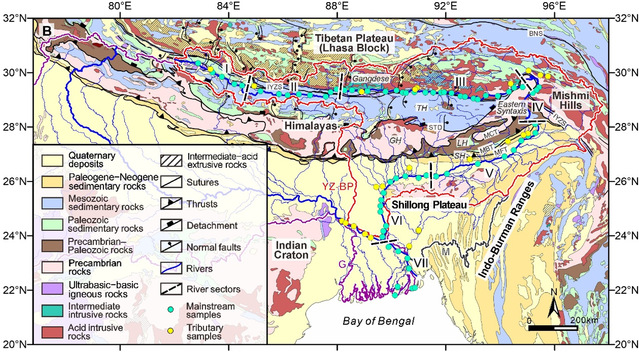Mingyang Yu 1, Zhifei Liu 1 *, Yulong Zhao 1, Baozhi Lin 1, H.M. Zakir Hossain 2, Suchana Taral 3,Tapan Chakraborty 4,Christophe Colin 5,Zhongpeng Han 6,Chengshan Wang 6
1 State Key Laboratory of Marine Geology, Tongji University, Shanghai, China.
2 Department of Petroleum and Mining Engineering, Jashore University of Science and Technology, Jashore, Bangladesh.
3 Department of Earth Sciences, Pondicherry University, Pondicherry, India.
4 Geological Studies Unit, Indian Statistical Institute, Kolkata, India.
5 Université Paris-Saclay, CNRS, GEOPS, Orsay, France.
6 Institute of Earth Sciences, China University of Geosciences (Beijing), Beijing, China.
*Corresponding author.
Email: lzhifei@tongji.edu.cn
Abstract:
The Tibetan Plateau (TP)-Himalayan system and its originating large rivers contribute ∼40% of the total terrestrial sediments in the global oceans. Understanding transport processes of these sediments is a prerequisite for interpreting marine sedimentary archives. Here, modern sands were collected along the Yarlung Zangbo−Brahmaputra−Ganges river system to trace sediment provenance and transport processes from the TP to the Bengal Delta by analyzing major elements and Nd-Sr isotopes. We find that higher Na2O/SiO2 and K2O/SiO2 ratios and more radiogenic εNd (−10 to −8) and less radiogenic 87Sr/86Sr (0.7096−0.7215) in the upper and eastern-middle Yarlung Zangbo River mainly reflect greater TP (Lhasa Block) contributions, while the reverse in the western-middle Yarlung Zangbo River (εNd: −13 to −9; 87Sr/86Sr: 0.7174−0.7210) indicates greater Tethyan Himalayan contributions. In contrast, less radiogenic εNd (−17 to −10) and more radiogenic 87Sr/86Sr (0.7164−0.7516) in the lower Yarlung Zangbo−Brahmaputra−Ganges river system indicate dominant Greater and Lesser Himalayan contributions. We estimate that at the present-day time scale the TP accounts for ∼61% of sands upstream of the Eastern Syntaxis and contributes only ∼18% to the Bengal Delta. A predominance of ∼72% of the Bengal Delta sands are derived from the Greater and Lesser Himalayas. The decreasing TP contributions downstream imply sediment retention resulting from two-level tectonic trapping of the Eastern Syntaxis and the Himalayan foreland basin. The prominent Greater and Lesser Himalayan contributions indicate strong erosion of the Himalayan front, favored by heavy monsoon rainfall. Our study implies that the influence of TP-derived detritus on the ocean floor is buffered during onshore transport.
Full article: https://doi.org/10.1130/B37912.1

Fig.1 Geologic sketch of the Tibetan Plateau to the Bengal delta with surface sediment sampling locations in the Yarlung Tsangpo-Brahmaputra-Ganges River basin

Fig.2 Spatial variation in the relative contribution of Yarlung Tsangpo-Brahmaputra-Ganges source regions to sedimentary sands in the basin

Fig.3 Schematic model of sedimentary sand transport from the Tibetan Plateau to the Bangkok Delta

